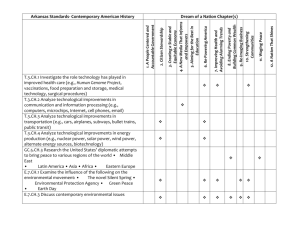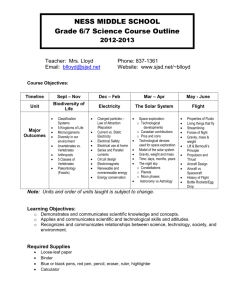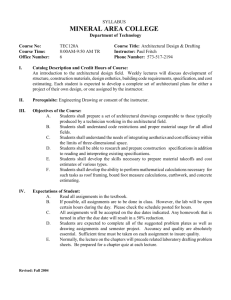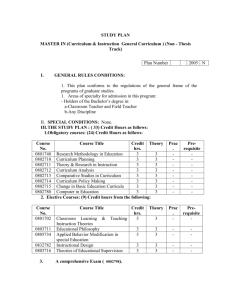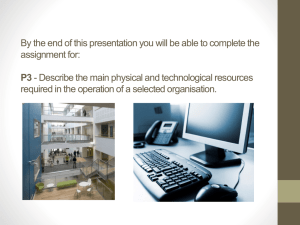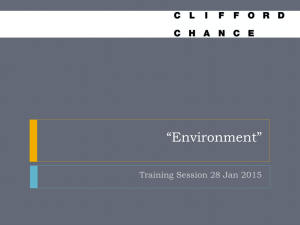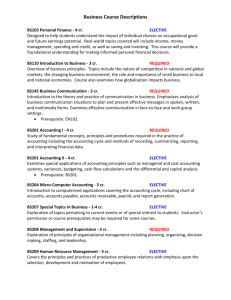COURSE TITLE:
advertisement
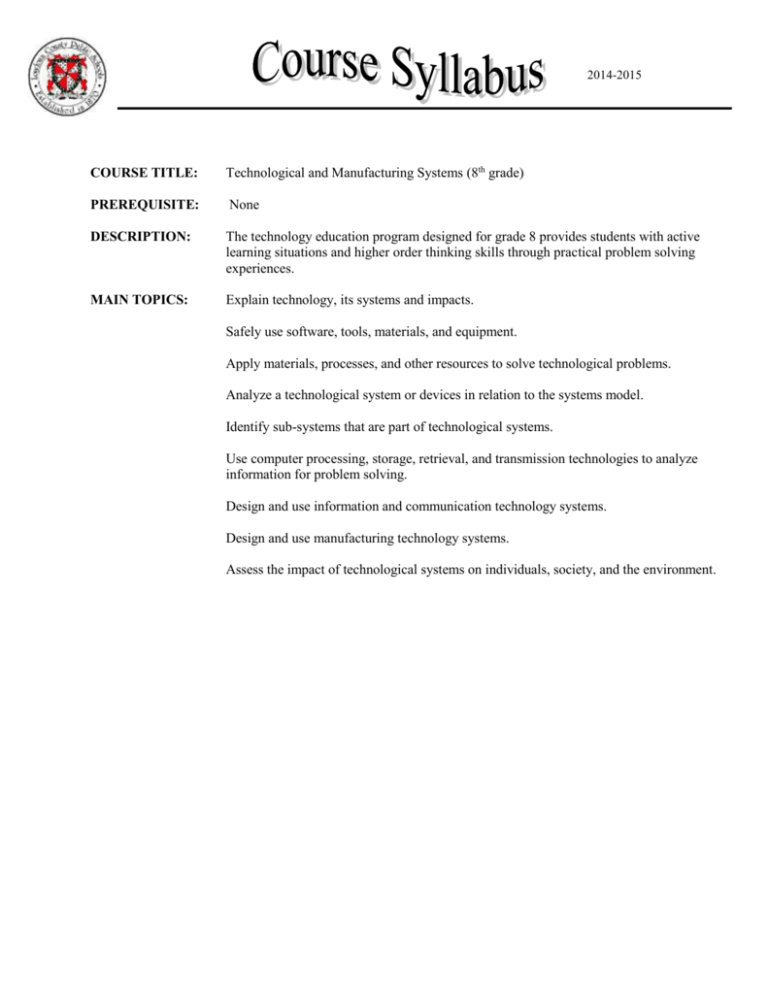
2014-2015 COURSE TITLE: Technological and Manufacturing Systems (8th grade) PREREQUISITE: None DESCRIPTION: The technology education program designed for grade 8 provides students with active learning situations and higher order thinking skills through practical problem solving experiences. MAIN TOPICS: Explain technology, its systems and impacts. Safely use software, tools, materials, and equipment. Apply materials, processes, and other resources to solve technological problems. Analyze a technological system or devices in relation to the systems model. Identify sub-systems that are part of technological systems. Use computer processing, storage, retrieval, and transmission technologies to analyze information for problem solving. Design and use information and communication technology systems. Design and use manufacturing technology systems. Assess the impact of technological systems on individuals, society, and the environment. 2014-2015 COURSE TITLE: Applied Technology II PREREQUISITE: Applied Technology I DESCRIPTION: Students will learn to use different technologies in a hands-on class to build on the experiences in Applied Technology I. These activities will include using computers, remote con trolled vehicles, video equipment, electronics, and satellites. Students are challenged to use these technologies to solve practical and real life problems. MAIN TOPICS: Applying the foundations of technology. Integrating technological systems and other school disciplines. Identify and explain the problem-solving process. Apply the technological method as a problem-solving process. Use tools, machines, materials, and processes properly . Identify components of a design log. Identify science laws and principles that are applicable to technology. Demonstrate and practice group cooperation and leadership skills. Meet responsibilities as defined by the problem-solving team. Identify a major technological problem and design a system to solve it. Demonstrate the use of math, science, language arts, and social studies to help solve technological problems. Identify and assess the impacts of technological systems on society and the environment. Examining all aspects of industry. CREDIT INFO: This course is a one credit elective required for the Standard or Advanced Diploma. 2014-2015 COURSE TITLE: Applied Technology I PREREQUISITE: None DESCRIPTION: This course is a hands-on class that reflects current and future technologies. This course will serve as a foundation for a lifetime of interest and application. Students design and improve technology through problem-solving activities. Technologies to be explored include biotechnology, communications, construction, manufacturing, power & energy, and transportation. MAIN TOPICS: Using information as a technological resource. Using materials as a technological resource. Using energy as a technological resource. Analyzing consumer products. Building and controlling a system with computers or electronics. Designing or improving a new product. Examining all aspects of industry: Planning Management Finance Technical and Production Skills Underlying principles of technology Labor issues Community issues Health, safety, and environmental issues. CREDIT INFO: This course is one elective credit elective required for the Standard or Advanced Studies Diploma. 2014-2015 COURSE TITLE: Applied Technology III PREREQUISITE: Applied Technology II DESCRIPTION: Applied Technology III gives students the chance to explore many problems in the community and the opportunity to develop solutions. It allows students to make improvements on existing products using the skills and technologies learned from the Applied Technology II course. Students explore a project-based cooperative learning environment. MAIN TOPICS: Analyzing the fundamentals of technological assessment. Appraising the technological factors that altar society. Forecasting future technologies, using normative techniques. Forecasting future technologies, using exploratory techniques. Applying technology assessment processes. Designing a technical product. Designing a technical system. Examining all aspects of industry: Planning Management Finance Technical and production skills Underlying principles of technology Labor issues Community issues Health, safety, and environmental issues CREDIT INFO: This course is a one-credit elective required for the Standard or Advanced Studies Diploma. 2014-2015 COURSE TITLE: Construction PREREQUISITE: None DESCRIPTION: This is a laboratory class that allows students to explore the construction industry. Students learn the processes by designing, building, and testing scale model structures. Through projects, students learn the work of architects, carpenters, electricians, plumbers, surveyors, contractors, masons, design engineers, and a variety of other construction careers. MAIN TOPICS: Develop an overview of constructing systems: Define terms associated with construction systems Follow safety rules and procedures Identify impacts of construction Investigate careers and career pathways associated with construction. Explore construction processes. Examine the impacts of construction. Examine all aspects of industry: Planning Management Finance Technical and production skills Underlying principles of technology Labor issues Community issues Health, safety, and environmental issues. CREDIT INFO: This course provides one elective credit for the Standard or Advanced Studies Diploma. 2014-2015 COURSE TITLE: Technology Education I PREREQUISITE: None DESCRIPTION: Students assess the relationship between production and society as they compose design portfolios, construct production prototypes, and apply automation to evaluate their solutions to technological problems. MAIN TOPICS: Demonstrate workplace readiness skills. Examine all aspects of industry. Address elements of student life. Explore the nature of technology. Examine technology and society. Analyze design. Practice safety. Develop abilities for a technological world. Examine the design world. CREDIT INFO: This course provides one elective credit required for the Standard or Advanced Studies Diploma. 2014-2015 COURSE TITLE: Technology Education II PREREQUISITE: Technology Education I DESCRIPTION: Students focus on industrial/technical materials and processes as they fabricate usable products and conduct experiments. Learning experiences include careers, as well as the use of tools/equipment related to analysis, testing, and processing of metals, woods, plastics, and other materials. MAIN TOPICS: List technological developments related to materials and processes technology. Evaluate careers related to industrial materials and processes. Describe and utilize the skills of an engineering team. Investigate community industrial and technical resources related to materials and processes technology. Explain the basic structure of atoms and ions. Describe the structure of amorphous and crystalline materials. Explain how materials are classified. Compare chemical properties of selected materials. Use measuring, layout, and drafting tools. Compare the design processes for custom and mass production. Plan a group marketing enterprise. Examine all aspects of industry. CREDIT INFO: This course provides one elective credit required for the Standard or Advanced Studies Diploma. 2014-2015 COURSE TITLE: Aerospace Science PREREQUISITE: None DESCRIPTION: Aerospace Science is a study of the interrelationship between aeronautics and space science. Students will use a hands-on approach to study concepts including aerodynamic principles, aircraft and spacecraft technologies, meteorology and space environments, commercial applications, administration, and historical perspectives. Field experiences will expose students to career paths in the aerospace industry and governmental agencies. MAIN TOPICS: Students will learn and be able to explain how an aircraft is able to fly using Bernoulli’s Laws, Newton’s Laws, and the forces of flight. Students will learn how an aircraft works as a system and the design function factors involved. Students will study the basic elements of the flight environment and the critical weather hazards that affect flight. Students will learn about airport and flight operations. Students will explore the history of flight and the emerging technologies of the future. Students will learn about rocket science, explore the factors of gravity, thrust, weight, the Laws of Physics, and stability systems. Students will learn about orbital science and the space environment. Students will explore the topic of spacecraft; examining all aspects of manned and unmanned flight. Students will study the mechanics of space flight, which include investigating orbits, navigation, propulsion, trajectory, and interplanetary flight. Students will explore the topics of living and working in space as well as the future of space flight & travel. CREDIT INFO: This course provides one elective credit required for the Standard or Advanced Studies Diploma. 2014-2015 COURSE TITLE: Computer Aided Drafting & Design I PREREQUISITE: None DESCRIPTION: Computer Aided Drafting and Design provides the student with the basic principles and theories underlying graphic representations, which are common to all areas of industrial work. Learning units and required drawings emphasize the basic skills in computer assisted drawing (CAD) and related areas. Occupational information is also presented. MAIN TOPICS: Describe and apply the design process. Analyze design solutions. Construct a prototype. Refine the design solution. Define technical drawing and the history of drawing/design. Maintain a reference library of technical data and drawing equipment. Select drawing-related media and materials to effectively communicate a solution for a design problem. Apply geometric construction principles. Apply mathematical calculations to technical drawings. Apply English and metric measuring devices and systems to technical drawings. Interpret technical documentation. Apply principles of dimensioning, annotation and lettering. Create a title block. Apply technical drawing and design standards. Develop 2-D patterns from 3-D objects. Prepare technical sketches. Revise drawings. Prepare multi-view, sectional, pictorial and architectural drawings. Create solutions, using computer-aided drafting and design (CADD). CREDIT INFO: This course provides one elective credit required for the Standard or Advanced Studies Diploma. 2014-2015 COURSE TITLE: Computer Aided Drafting & Design II PREREQUISITE: CADD I DESCRIPTION: This course is designed to give the college bound student an opportunity to explore specific fields related to Computer Aided Drafting and Design. These areas are architectural, electrical, sheet metal, structural, topographical, and mechanical. The student then chooses areas of interest and pursues independent, in-depth studies. MAIN TOPICS: Define architectural design. Analyze architectural styles. Maintain a reference library of architectural data. Estimate construction costs. Calculate square footage. Research building and zoning code information. Apply architectural principles of annotation and dimensioning. Identify the components in a complete set of architectural drawings. Create an architectural title block. Define the architectural design process and apply elements and principles to create a solution. Build presentation models. Incorporate green technology into architectural design. Design a functional floor plan. Identify ADA regulations. Develop a site analysis. Prepare design sketches. Draw a functional floor plan. Design a foundation plan. Draw an electrical plan. Create sectional and perspective views. Render design drawings. Design exterior and interior elevations. Create door and window schedules. Create architectural design solutions using CADD (computer aided drafting and design). Create a walk-through presentation of a section of a building. CREDIT INFO: This course provides one elective credit required for the Standard or Advanced Studies Diploma.
